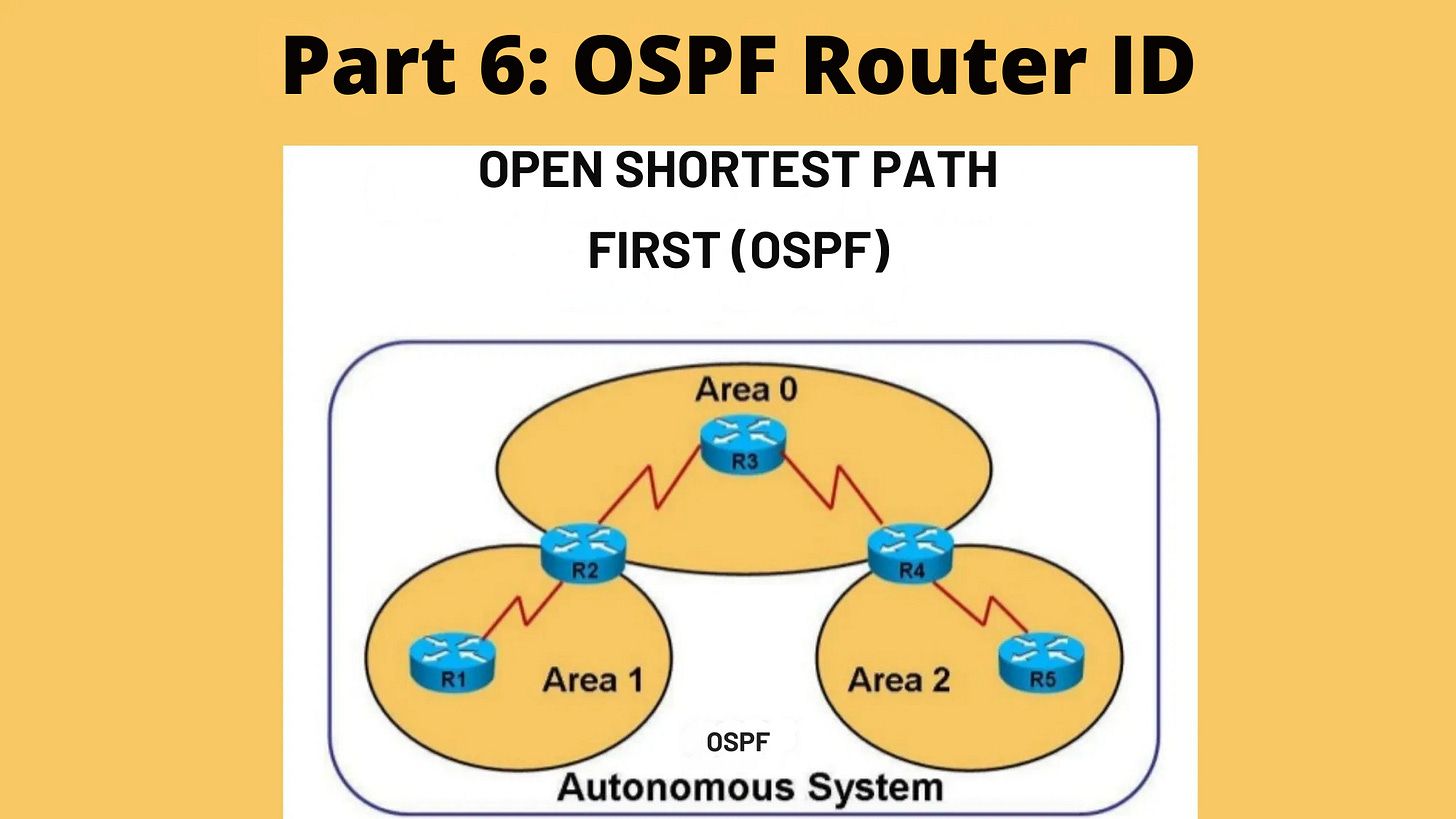Part 6: OSPF Router ID
Open Shortest Path First Routing Protocol
The OSPF Router ID (RID) is a critical component of the Open Shortest Path First (OSPF) protocol, uniquely identifying a router within the OSPF topology and Link-State Database (LSDB). This post details the Router ID’s purpose, election process, configuration, stability considerations, and its impact on OSPF operations.
What is the Router ID?
The Router ID is a 32-bit identifier represented in dotted-decimal notation (e.g., 1.1.1.1), resembling an IP address but not required to be an assigned IP address. It serves as the unique name of an OSPF router in the topology and LSDB.
Purpose: Identifies the router in OSPF Link-State Advertisements (LSAs), neighbor relationships, and virtual link configurations.
Requirement: OSPF cannot start without a Router ID. If no RID is assigned, the OSPF process fails to initialize, generating an error:
*Jul 19 12:00:40.926: %OSPF-4-NORTRID: OSPF process 1 failed to allocate unique router-id and cannot startRouter ID Election Process
The Router ID is determined through a hierarchical election process, executed when the OSPF process starts:
Manually Configured Router ID (Highest Priority):
Explicitly set under the OSPF process.
Configuration:
R1(config)# router ospf 1
R1(config-router)# router-id 1.1.1.1Takes precedence over all other methods.
Highest Loopback Interface IP Address:
If no Router ID is manually configured, OSPF selects the highest IP address among active loopback interfaces.
Loopback interfaces are preferred because they are always up unless the router crashes, ensuring stability.
Administratively down loopback interfaces are excluded from the election.
Highest Physical Interface IP Address:
If no loopback interfaces exist, OSPF selects the highest IP address among active physical interfaces.
Physical interfaces are less preferred due to their susceptibility to link failures.
Note: The election occurs only at OSPF process initialization or after a process reset, ensuring the RID remains stable during normal operation.
Router ID Stability and Change Behavior
Once elected, the Router ID is non-preemptive, meaning a better candidate (e.g., a higher IP address or new manual configuration) does not automatically take effect. The behavior depends on the router’s state:
No Neighbors:
If the router has no OSPF neighbors, a new Router ID (configured via router-id) takes effect immediately.
Example:
R1(config)# router ospf 1
R1(config-router)# router-id 2.2.2.2Existing Neighbors:
If the router has active OSPF neighbors, changing the Router ID requires clearing the OSPF process to take effect:
R1# clear ip ospf processClearing the OSPF process triggers a full Shortest Path First (SPF) recalculation and temporarily disrupts adjacencies, recomputing the OSPF topology tree.
Caution: Avoid frequent OSPF process resets in production networks, as they can cause routing instability.
Implications of Duplicate Router IDs
Duplicate Router IDs in an OSPF domain cause significant issues, as the RID must be unique to identify routers in the LSDB:
Directly Connected Routers:
Two routers with the same Router ID cannot form a neighbor relationship if directly connected, as OSPF detects the conflict during Hello packet exchange.
Adjacency remains in the Down or Init state.
Same Area, Separated by Another Router:
Two routers with the same Router ID in the same area, but not directly connected, may form neighbor relationships with intermediate routers.
However, this causes LSDB inconsistencies, as LSAs from both routers are indistinguishable, leading to incorrect SPF calculations.
Different Areas:
Duplicate Router IDs in different areas trigger an LSA flooding war, where routers continuously reflood conflicting LSAs, destabilizing the OSPF domain.
Virtual Links:
Router IDs are critical for virtual link configuration, as they identify the endpoints of the link (e.g., area <transit-area> virtual-link <remote-RID>).
Duplicate RIDs prevent proper virtual link establishment.
Best Practices
Explicit Configuration: Always configure the Router ID manually under the OSPF process to ensure predictability and consistency:
R1(config)# router ospf 1
R1(config-router)# router-id 1.1.1.1Naming Convention: Use a Router ID format tied to the router’s name or role (e.g., 1.1.1.1 for R1) for easy identification in the topology.
Uniqueness: Ensure each router has a unique Router ID to avoid LSDB conflicts and adjacency failures.
Loopback Preference: When not manually configured, assign IP addresses to loopback interfaces to leverage their stability for RID election.
Minimize Process Resets: Plan Router ID changes carefully to avoid unnecessary OSPF process resets, especially in production environments.
Verification Commands
To verify the Router ID and troubleshoot related issues, use the following Cisco IOS/IOS XE commands:
Show OSPF Process:
R1# show ip ospfDisplays the Router ID, OSPF process details, and area information.
Show OSPF Interface:
R1# show ip ospf interface [type number]Confirms interface IP addresses and their role in RID election (if not manually set).
Show Running Configuration:
R1# show running-config | section ospfVerifies manual Router ID configuration.
Debug OSPF Adjacency (use with caution in production):
R1# debug ip ospf adjIdentifies adjacency failures due to duplicate Router IDs or other issues.
IOS XR Equivalents:
show ospf
show ospf interface [type number]
show running-config router ospf
debug ospf adj
Key Considerations
Mandatory RID: OSPF requires a Router ID to start; failure to allocate one prevents process initialization.
Non-Preemptive: The Router ID remains stable unless the OSPF process is cleared, ensuring topology consistency.
Duplicate RID Issues: Duplicate Router IDs cause severe LSDB and adjacency problems, particularly in the same area or across virtual links.
Loopback Advantage: Loopback interfaces are preferred for RID election due to their always-up state, reducing the risk of RID changes due to link failures.
Virtual Links: The Router ID is used to identify virtual link endpoints, making uniqueness critical.



